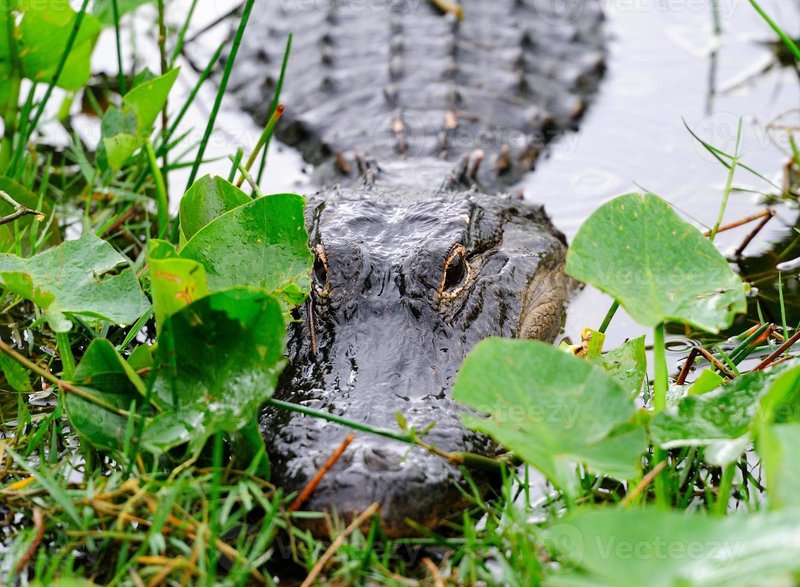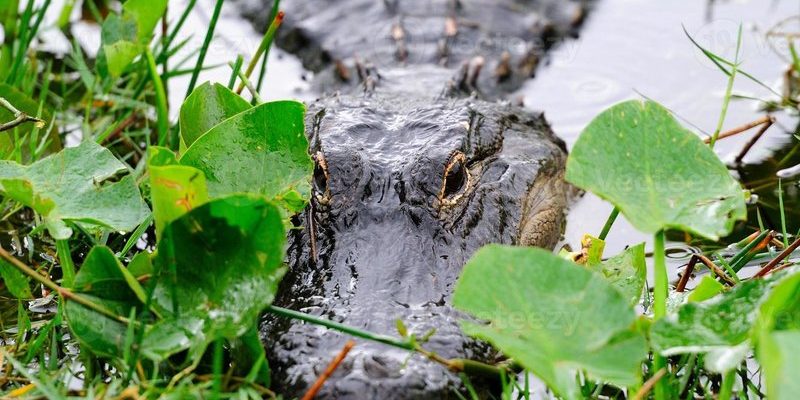
If you’ve ever seen an alligator, you know they can be quite intimidating. With their powerful jaws, armored skin, and strong tails, these reptiles are truly fascinating creatures. But there’s so much more to alligators than just their fearsome appearance. From their unique adaptations to their role in the ecosystem, alligators are a vital part of their habitats and exhibit some captivating behaviors. Let’s explore the world of alligators and uncover what makes these reptiles so intriguing.
Imagine walking by a serene swamp. The water is calm, and the sun casts a warm glow. Suddenly, you spot an alligator lounging on the bank, basking in the sunlight. It may look lazy, but this ancient predator is always alert, ready to act when the moment calls for it. Understanding alligators helps us appreciate their importance in nature and their remarkable survival skills over millions of years.
Physical Characteristics
Alligators are generally large reptiles, with the average adult measuring between 11 and 15 feet long. However, some can grow even larger! Their powerful jaws can exert an estimated 2,000 pounds of pressure, making them one of the strongest animals on the planet. What’s more, their skin is covered in tough, scaly armor that helps protect them from predators and injuries. In fact, alligator skin is composed of bony plates called osteoderms that provide a layer of defense.
The coloring of an alligator can vary significantly. They often have a dark green to blackish appearance, which helps them camouflage in murky waters. This coloration is crucial for hunting and hiding from potential threats. Their eyes and nostrils are positioned on the top of their heads, allowing them to see and breathe while mostly submerged. This adaptation is essential for the alligator’s survival, allowing it to be stealthy while waiting for prey.
One fascinating aspect of alligator anatomy is their tail. The tail makes up about half of their total length and is a powerful tool for swimming. Alligators can reach speeds of up to 20 mph in water by using their tails to propel themselves. On land, they are not as swift, moving at about 1-2 mph. Their unique design—powerful limbs, webbed feet, and muscular tails—enables them to thrive in both aquatic and terrestrial environments.
Habitat and Distribution
Alligators primarily inhabit freshwater environments such as ponds, marshes, rivers, and swamps. They are most commonly found in the southeastern United States, particularly in states like Florida and Louisiana. Here, the warm climate provides ideal conditions for these reptiles, allowing them to thrive year-round.
Besides the United States, alligators can also be found in parts of China, specifically the Yangtze River basin. This limited range makes them vulnerable, as any changes to their habitat can have significant impacts on their populations. Human activities like urban development, agriculture, and pollution pose serious threats to alligator habitats, emphasizing the need for conservation efforts.
During the breeding season, which occurs in the spring, alligators may travel to new locations to find mates. They are known to create nests near water, made of vegetation and mud, where females lay around 20-50 eggs. After hatching, the young alligators stay with their mother for protection, showcasing a nurturing side that’s often overlooked in reptiles.
Diet and Feeding Habits
Alligators are opportunistic feeders, meaning they will eat whatever prey is available. Their diet mainly consists of fish, birds, small mammals, and even other reptiles. Because they are cold-blooded, alligators don’t have high energy needs, which allows them to go days or even weeks without eating—an impressive survival trait.
When hunting, alligators rely on their stealth and patience. They often lie in wait, partially submerged, and use their powerful tails to propel themselves toward their prey with surprising speed. Once they capture their meal, they may perform a technique known as the death roll, where they spin in the water to disorient or tear apart their prey. This method is effective for larger animals, ensuring they can consume a substantial meal.
During the winter months, when food becomes scarce, alligators may slow down their metabolism and enter a state of lethargy. This adaptation helps them conserve energy until conditions improve. It’s another fascinating aspect of how alligators have evolved to survive in their environments for millions of years.
Behavior and Social Structure
Alligators are known for their interesting behaviors and social structures. Contrary to popular belief, they are not solitary creatures. While males tend to be more territorial, they often gather in groups, especially during the breeding season. During this time, you might hear loud bellowing sounds as males establish dominance and attract females. It’s somewhat like a vocal competition!
Mother alligators are also quite protective of their young. After the eggs hatch, the mother will carry the hatchlings gently in her mouth to the water, ensuring their safety. This maternal care is quite remarkable for reptiles and highlights a complex social structure that includes parent-offspring bonds.
Alligators are also known to be quite vocal, communicating through various sounds, including hisses, growls, and bellowing. These vocalizations serve multiple purposes, such as warning off intruders, signaling danger, or attracting mates. Their communication helps maintain social order and safety within their habitats.
Conservation Status
Alligators were once endangered due to habitat loss and hunting for their skin. However, thanks to conservation efforts, their populations have rebounded significantly since the 1970s. They are now listed as least concern by the IUCN, which is a positive change for these reptiles. Conservation programs focus on maintaining healthy ecosystems and protecting their habitats to ensure that alligators can thrive.
Despite their improved status, alligators still face threats from human activities, such as pollution, habitat destruction, and climate change. These challenges can disrupt their breeding practices and food sources, making it essential to continue conservation efforts. Education about alligator behavior and habitat is also crucial for fostering coexistence between humans and these magnificent creatures.
In some areas, alligator hunting is regulated to maintain population health while allowing for sustainable use. Responsible management practices balance the interests of conservation, tourism, and local economies. By understanding and respecting alligators, we can ensure their survival for generations to come.
Interesting Facts
| Average Length: | 11-15 feet |
| Diet: | Fish, birds, mammals, reptiles |
| Top Swimming Speed: | 20 mph |
| Average Lifespan: | 35-50 years in the wild |
| Coloration: | Dark green to black |
| Habitat: | Freshwater environments |
FAQ
What is the difference between an alligator and a crocodile?
This is a common question! While both belong to the same family of reptiles, there are distinct differences. Alligators typically have a wider, U-shaped snout, while crocodiles have a narrower, V-shaped snout. Additionally, when an alligator’s mouth is closed, only its upper teeth are visible, whereas a crocodile shows both upper and lower teeth. The habitats also differ; alligators prefer freshwater, while crocodiles can be found in both freshwater and saltwater.
Are alligators dangerous to humans?
Alligators are generally not aggressive towards humans but can become dangerous if provoked or if they feel threatened. Attacks are rare, and most alligators will avoid human contact. It is essential to respect their space, especially in their natural habitats. Always be cautious and observe them from a safe distance, as they can be unpredictable if they feel cornered.
How do alligators care for their young?
Mother alligators are surprisingly nurturing. After the eggs hatch, the mother will transport her hatchlings to the water by gently carrying them in her mouth. She remains protective during their early stages of life, ensuring they stay safe from predators. This level of care is quite fascinating for reptiles and shows that there is more to alligator behavior than one might think.
What do alligators eat in captivity?
In captivity, alligators are often fed a well-balanced diet that includes meat, fish, and specially formulated pellets. Providing a varied diet ensures they receive the necessary nutrients for healthy growth. Their diet will depend on their age, size, and health status. Caregivers often mimic their natural hunting patterns by offering live prey occasionally, which also helps stimulate their natural instincts.
Can alligators climb trees?
Yes, alligators can climb trees! While it may seem surprising, they can use their powerful limbs and sharp claws to scale low branches. This behavior is not common and is usually seen in younger alligators looking for sunbathing spots or a place to bask away from the water. It’s a helpful reminder that these creatures are more agile than they appear!
How can we help alligators in the wild?
Supporting conservation efforts is one of the best ways to help alligators. This includes promoting awareness about their habitats and the threats they face. Participating in local clean-ups helps keep their environments free from pollution. Additionally, advocating for policies that protect wetlands and natural habitats ensures that alligators have a safe place to thrive. Every effort counts!
What is the lifespan of an alligator in the wild?
Alligators typically live between 35 to 50 years in the wild, depending on environmental factors and threats. In captivity, where they are safe from predators and have a consistent food supply, they can live even longer—up to 65 years! This longevity highlights the importance of protecting their habitats and ensuring they can live out their natural lifespans.
Are alligators social animals?
While alligators are often seen as solitary creatures, they do engage in social behaviors, especially during the breeding season. Males will vocalize to establish territory and attract potential mates. Groups can also form when basking or during nesting season. Their social structure can be quite complex, showcasing behaviors that suggest they communicate more than we typically recognize.
Do alligators hibernate in winter?
Alligators do not hibernate in the traditional sense, but they enter a state of dormancy during colder months. They may slow down their metabolism and spend more time submerged in water, creating “an alligator hole” to survive freezing temperatures. This behavior helps them conserve energy until conditions improve, showcasing their fascinating adaptations to seasonal changes.
How do alligators contribute to their ecosystems?
Alligators play a crucial role in their ecosystems. As apex predators, they help control populations of various species, maintaining a balance in their environment. Additionally, their nesting activities create habitats for other wildlife and help manage wetland ecosystems. By promoting healthy ecosystems, alligators support biodiversity and contribute to the overall health of their habitats.
What is the biggest alligator ever recorded?
The largest alligator ever recorded was a whopping 19 feet 2 inches long, captured in Louisiana in 1890. This immense size showcases the potential for growth in these reptiles. However, such giants are incredibly rare, and most adult alligators fall within a more typical range of 11 to 15 feet. It’s fascinating to think about the size and age of these ancient creatures!

